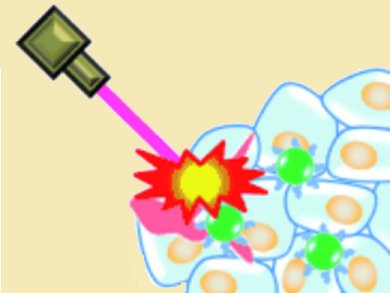Photothermal nanomaterials have the potential to treat cancer, either through the controlled delivery and release of chemotherapeutic drugs, or by targeting the tumor region with a laser-guided light source without surgical intervention.
Yong-Min Huh, Seungjoo Haam and colleagues, Yonsei University, Republic of Korea, have developed polyaniline-based nanoparticles (PANPs) for the thermal ablation of cancer cells. The PANPs took two forms: the emeralidine base and its salt. Switching between the two could be achieved by doping with phosphate-buffered saline or with biological dopants such as protons or other oxidative species present in the intracellular environment.
Formation of the emeralidine salt shifted the optical-absorbance peak toward the near-IR region. This generated a substantial amount of heat energy that could be used to kill cancer-cells without damaging surrounding tissue.
- Convertible Organic Nanoparticles for Near-Infrared Photothermal Ablation of Cancer Cells
J. Yang, J. Choi, D. Bang, E. Kim, E.-K. Lim, H. Park, J.-S. Suh, K.-H. Yoo, E.-K. Kim, Y.-M. Huh, S. Haam
Angew. Chem. Int. Ed. 2010, 49.
DOI: 10.1002/anie.201005075 - J. Yang, J. Choi, D. Bang, E. Kim, E.-K. Lim, H. Park, J.-S. Suh, K.-H. Yoo, E.-K. Kim, Y.-M. Huh, S. Haam
Angew. Chem. 2010, 122.
DOI: 10.1002/ange.201005075



